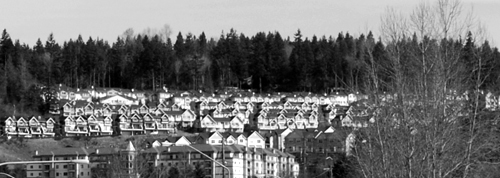
Recently during a drive along Interstate-90, just outside of Seattle, we passed by a large tract housing development on a hillside near Issaquah. The development immediately caught our attention for a reason that may seem a bit strange. At first glance it reminded us of some of the Italian hilltowns from our student days backpacking around Italy. We know, ridiculous right? Maybe our periphery vision failed us, maybe we had one too many martinis the night before, or maybe we’re just trying to hard. Whatever the case, we couldn’t get it out of our heads. There were inexplicable similarities in the overall composition, massing and patterns.
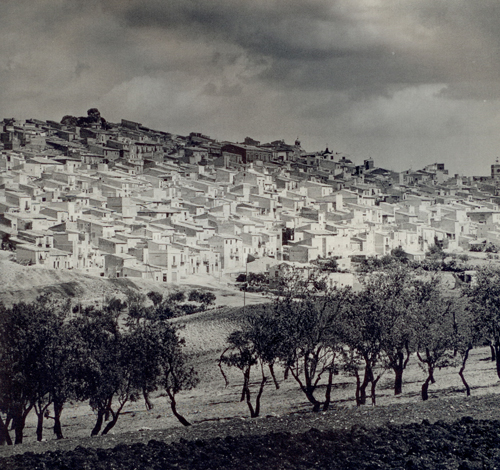
[Pietraperzia Hilltown photo from “Italian Hilltowns”, by Norman F. Carver Jr.]
What troubles us though is this; despite the first-glance similarities, why are tract housing developments in America so incredibly dull and soul-less, while even the most insignificant Italian hilltown is filled with curiosity, culture and life? It’s certainly not a lack of materials or absence of technology. It’s not indolence or scarcity of inhabitants. There is no lack of gently cascading hills and picturesque landscapes here in the northwest. The dwellings in these hilltowns don’t cost more to build or purchase than a typical tract home.
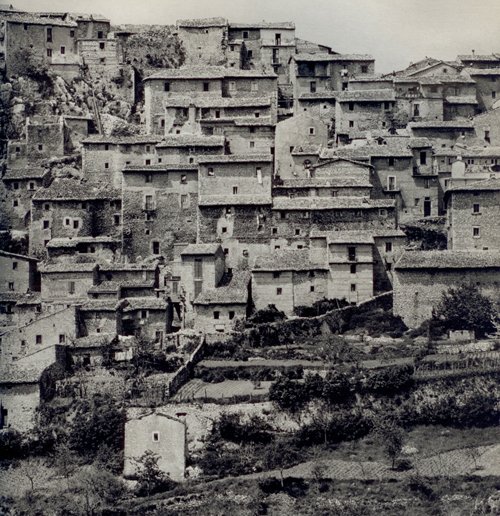
[Pietra Secca Hilltown photo from “Italian Hilltowns”, by Norman F. Carver Jr.]
We seem to possess everything physical and metaphysical to produce something as quaint as the Italian hilltown, and yet culturally and experientially we’re not even hitting the broad side of the proverbial barn. Quite the opposite, we’re creating short- term habitats that are detrimental to the quality of our physical and psychological environments.
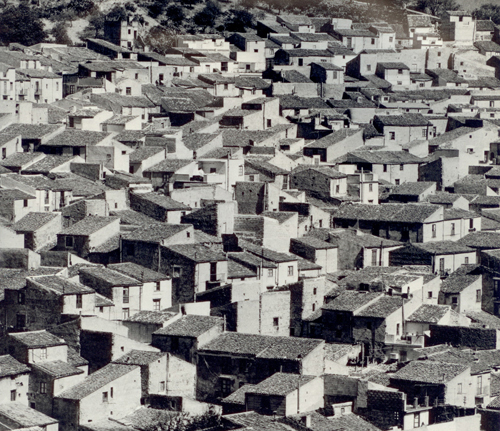
[Cefalu Hilltown photo from “Italian Hilltowns”, by Norman F. Carver Jr.]
Being the curious architects that we are – we just couldn’t help but pick this issue apart. So we chose the Sicilian Hill town of Pietraperzia to break down and compare with Issaquah Ridge (which could be just about any development in the northwest). Some of these attributes are obvious but we’re going to think out loud here, share your thoughts.
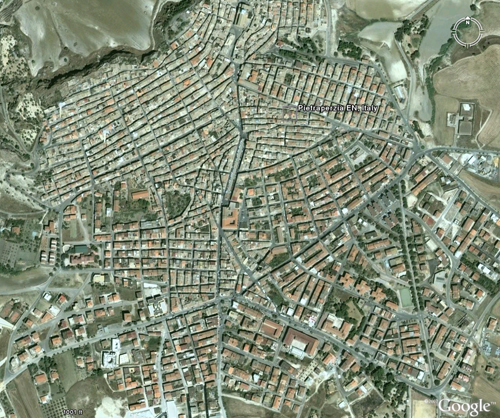
[Pietraperzia Hilltown at 1000 feet, photo courtesy Google Earth]
Top 10 Similarities
1. Topography & stepping
2. Relative scale
3. Absence of vegetation within the development
4. Articulation of individual dwellings
5. Shared walls
6. Similarity of materials between dwellings
7. Perceived density
8. Relatively orthogonal streets
9. A prominent main street
10. Underground utilities
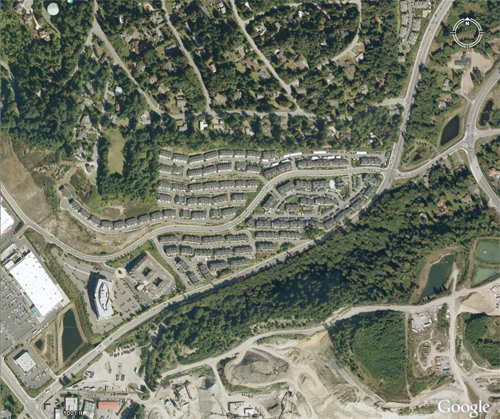
[Issaquah Ridge at 1000 feet, photo courtesy Google Earth]
Top 10 Differences
1. After a napkin-sketch analysis; the density of the tract housing development would be equal to approximately 5,352 dwellings per square mile, whereas the density of the hilltown would be equal to approximately 16,500 dwellings per square mile, more than 3 times as many dwellings within the same area.
2. The hilltown seems to have grown into the landscape whereas the tract housing has situated itself with disregard to the landscape – leaving an awkward cliff wall of trees in the background.
3. Internal and private gardens exist at random within the hilltown whereas green space (the yard) is equally distributed in the tract housing.
4. There are many more anomalies amongst dwellings in the hilltown, whereas the tract housing is much more regular in form.
5. There is a messiness about the hilltown that the tract housing lacks.
6. There is greater articulation and more penetrations in the tract housing – more doors and windows. The walls of the dwellings in the hilltown are more solid and massive.
7. There appears to be variations of zoning in the hilltown as church steeples mix in with the dwellings. The tract housing allows for one type of use.
8. The streets of the tract housing are much more generous indicating that the automobile is more prominent. The hilltown seems to be calibrated for pedestrians and bicycles.
9. The volumes of tract houses are much larger in plan view than the volumes of the hilltown dwellings (a bit misleading from the perspective photo).
10. The hilltowns have occurred over decades and generations whereas the tract home developments were probably built from start to finish in less than two years.
Conclusion
Issues of quality, experience of place and poetics of architecture in our built-environment are, of course, a much larger matter and we’ve only taken a tiny snapshot of the overall picture in this post. In the event that our observations are a decent representation of the larger picture, we’ve got a series of suggestions to forward the discussion and begin solving what is increasingly becoming an enormous problem in our built environment.
A. We’re doing too much. We’re over thinking, over regulating and over standardizing our dwellings in the northwest. The state, city and community leaders need to relax building codes and covenants to allow for more anomaly, more experimentation and, quite frankly, more messiness.
B. As homeowners we need to work better together. The legal and physical lines separating what’s yours from what’s mine are generating dull, regulated living environments. We’re not suggesting a system of co-ops and communes but simple items like shared driveways, shared back yards and community courtyards would make a tremendous difference in the quality and experience of the built-environment. We need to stop suing each other and begin negotiating our differences face to face. We need to stop relying on the building departments for solutions (refer to A) and instead cooperate at the neighborhood level.
C. Banks need to start lending again. Without access to home loans and construction loans the population is dependent on large-scale self-funded developers for housing. Most large scale developers have more of an obligation to shareholder profits than they do to the homeowner in producing a timeless and quality environment.
D. Large-scale developers of tract homes need to be kept in check. They need to be held accountable for the quality of life (or lack thereof) that they impose on people. They need to hire architects rather than drafters.
E. We need to break our dependence on the illusion of the single family home. With a front yard, back yard, two side yards and a white picket fence these developments are wasting space and creating a schism of how we think we’re living and how we’re actually living <cue the golden retriever with the Sunday paper in it’s mouth>. Most of tract housing is simply the illusion of the rural farm house. It is much more effective to design and build practical housing without the false appearances that we seem to be fixated on as a culture.
F. Explore transportation options in addition to your car.
G. Slow down. We’re building too fast to make reasonable decisions. Communities take time to develop.
For more information about the hilltowns shown above we recommend purchasing Italian Hilltowns by Norman F. Carver Jr.





